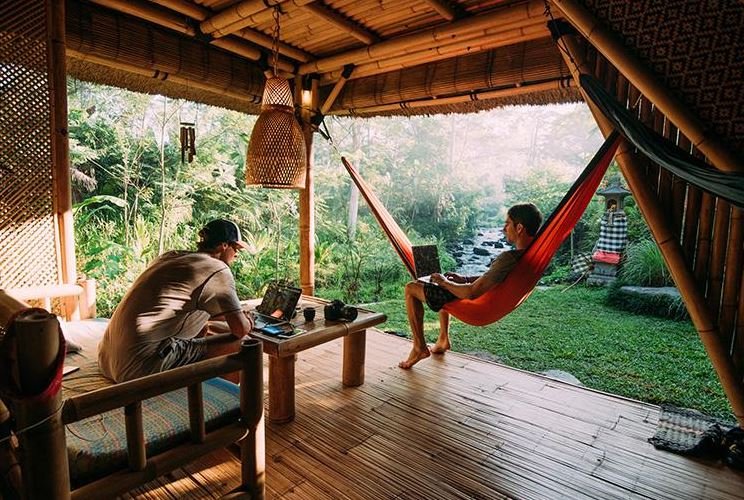Bali Stay Ideas: 7 Villas That Gave Me Stories to Remember in Ubud, Canggu & Seminyak
There’s something about Bali that stays with you long after the plane ride home. Maybe it’s the smell of incense in the... Read More

Living off-grid in Bali is a dream for many — the idea of disconnecting from the hectic pace of modern life and immersing yourself in nature’s rhythm is deeply alluring. This Indonesian island, renowned for its lush landscapes, rich culture, and spiritual energy, has become a hotspot for those seeking an alternative lifestyle. But what does it really mean to live off-grid in Bali? How do people manage without the usual urban comforts? And what are the rewards and challenges of such a life?
In this comprehensive article, we’ll explore the realities of off-grid living in Bali, from setting up your home without electricity from the grid, sourcing water, connecting with local communities, embracing sustainable living, and experiencing the unique cultural fabric of this tropical paradise.
Bali is not just another island; it’s a cultural and spiritual haven. For decades, artists, yogis, digital nomads, and eco-enthusiasts have flocked here for its breathtaking beaches, vibrant ceremonies, and lush jungles. But Bali is also evolving. Amid its popular tourist hubs lie quiet villages and untouched nature — perfect spots for those wanting to live self-sufficiently and sustainably.
The island’s natural beauty, warm climate year-round, and relatively affordable cost of living make it ideal for off-grid living. Plus, Bali’s welcoming community of locals and expatriates fosters a shared passion for preserving the environment and embracing traditional ways.
Living off-grid means disconnecting from the centralized utility infrastructure — no municipal electricity, water, or sewage systems. Instead, you generate your own power, collect and purify water, manage waste yourself, and often grow your own food.
In Bali, this can look like:
This lifestyle requires preparation and adaptation but offers freedom, sustainability, and a deeper connection to nature.
The first step to off-grid living is finding land. Bali offers a range of options, from dense jungle parcels in Ubud or Munduk to beachside plots in quieter regions like Amed or East Bali. When scouting locations, consider:
Local regulations and land ownership can be complex in Bali, so it’s crucial to work with reputable agents or local advisors to navigate legalities.
Many off-grid dwellers in Bali prefer eco-friendly, low-impact building methods that blend with nature. Traditional Balinese architecture, using bamboo, alang-alang grass (for roofing), and reclaimed wood, is both sustainable and aesthetically beautiful.
Modern off-grid homes incorporate:
This approach reduces energy consumption, minimizes environmental impact, and creates a serene living space that honors Bali’s natural surroundings.
Electricity is often the biggest challenge living off-grid in Bali. While the island’s national grid is generally reliable in towns, remote locations require self-generated power.
Solar panels are the most popular choice because of Bali’s abundant sunlight. Many off-gridders invest in:
Some also use small wind turbines or micro-hydro systems if near streams. Managing power usage becomes a daily practice of mindfulness and innovation.
Water is essential, and Bali’s tropical climate allows for rainwater harvesting as a primary source. Many off-grid homes have large storage tanks that collect rainwater from rooftops, filtered for drinking and daily use.
In addition:
Water management is critical to health and sustainability.
Without municipal sewage, managing human and household waste responsibly is vital. Many off-grid Bali residents use composting toilets, which decompose waste naturally without water, reducing pollution risks.
Organic kitchen and garden waste are composted and reused as fertilizer, closing the loop in sustainable living.
One of the greatest joys of off-grid living is cultivating your own food. Bali’s fertile soil and warm climate allow for year-round gardening. Popular crops include:
Many off-gridders practice permaculture principles, integrating plants and animals for a balanced ecosystem.
Living off-grid in Bali isn’t just about solitude. The island’s rich culture emphasizes community, spirituality, and respect for nature.
Off-grid residents often participate in:
Building relationships with local neighbors enriches the off-grid experience and ensures cultural sensitivity.
Many off-grid Bali residents are digital nomads or remote workers who balance internet connectivity with nature immersion. While off-grid can mean limited power and connectivity, innovations like solar-powered internet boosters, satellite connections, and community hubs help keep people connected without sacrificing sustainability.
Living off-grid isn’t always idyllic. Challenges include:
Resilience, flexibility, and a strong problem-solving mindset are essential.
Despite challenges, off-grid living in Bali offers unmatched rewards:
For many, it’s a transformative experience, reshaping values and lifestyle.
Preparation and openness lead to success.
Many expats and locals share inspiring stories of adapting to off-grid life: from turning a jungle clearing into a thriving garden, to overcoming power outages with ingenuity, to experiencing profound peace in nature’s embrace. These stories motivate others to explore a more intentional way of living.
Living off-grid in Bali is a unique adventure blending sustainability, culture, and natural beauty. It’s not for everyone, but for those seeking a slower, more conscious lifestyle, it offers incredible rewards and growth. Whether you’re dreaming of a solar-powered bamboo hut in the jungle or a permaculture farm by the sea, Bali can be the place where off-grid dreams come alive
Join The Discussion